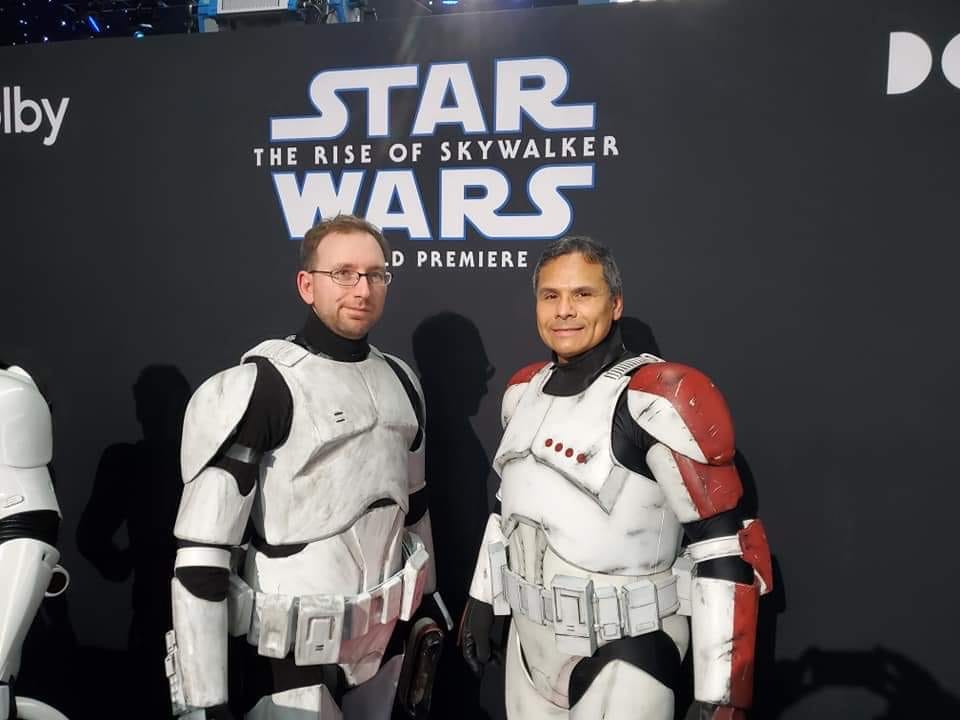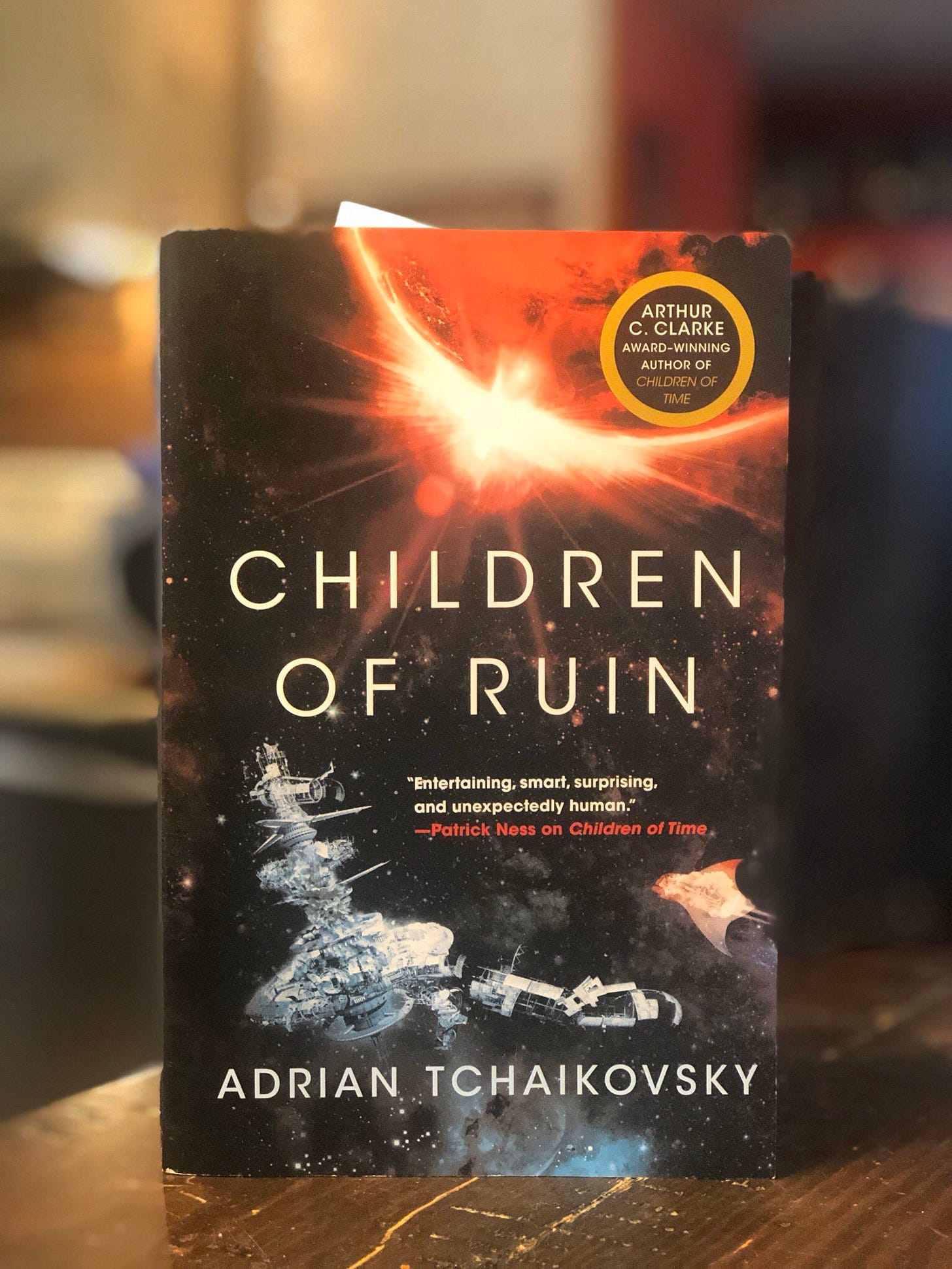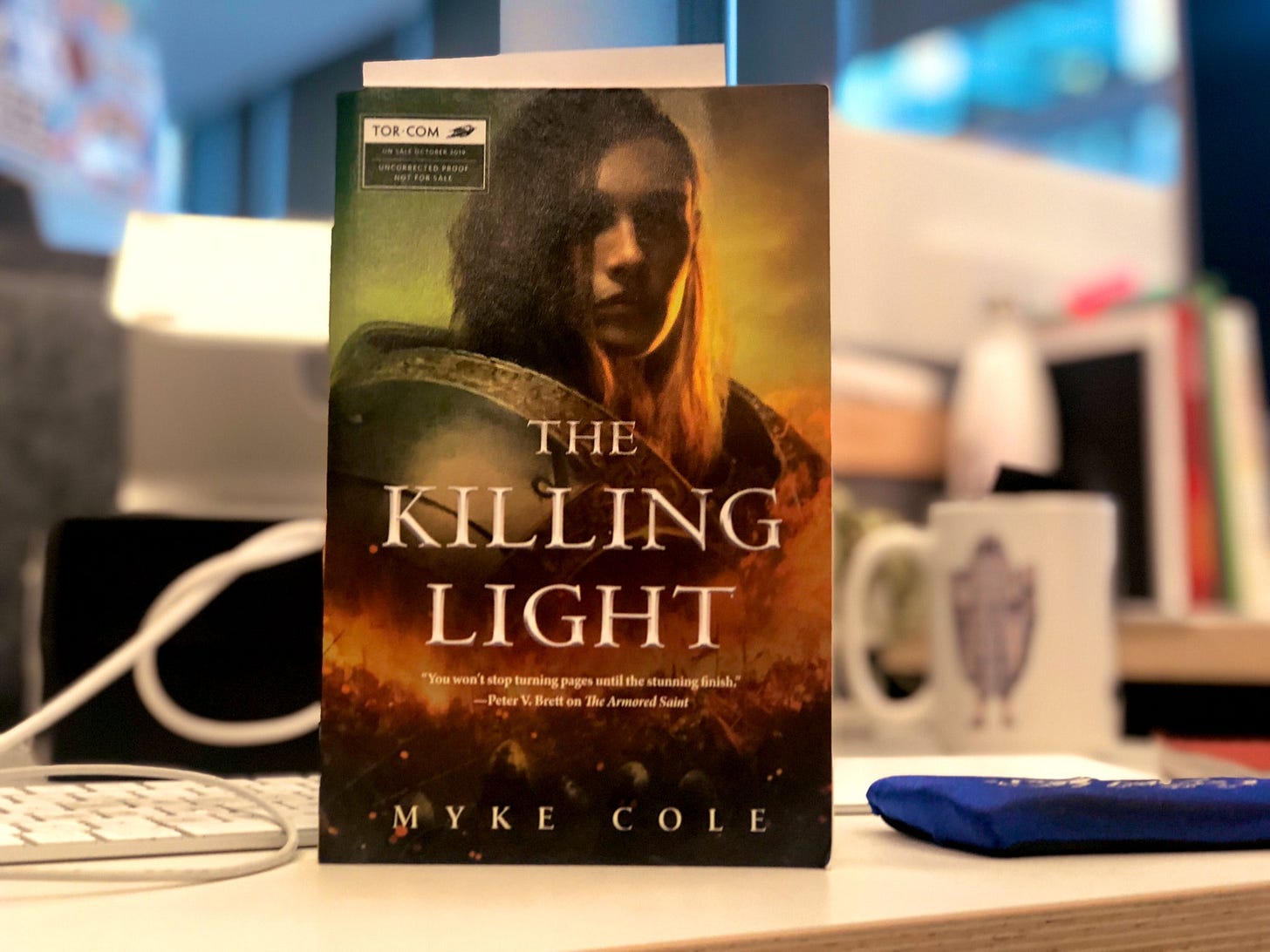Rise of Skywalker, Octopuses in space, and grimdark finales

Hello!
I was on the road this past weekend on a secret mission to California: I attended the world premiere of Star Wars: The Rise of Skywalker! I made a bit of an extended trip out of it, and had a blast.
I meant to get this letter out before the trip, but there was a lot that I had to do ahead of time.
Premiere Ops
A TIE Fighter screams overhead, and reflexively, I duck. I know that they’re not real, but I couldn’t help it. I’m sitting in the middle of a courtyard in Disneyland’s Galaxy’s Edge, and I’m in Star Wars.
I was in LA to attend the premiere of Rise of Skywalker, part of a contingent of 501st and Rebel Legion members who were invited to attend the festivities. I don’t get out to California all that often — my last trip was in 2018 to San Diego Comic-Con — and I figured that while I was in the area, I might get some things done while out there.
I flew out to San Francisco on Friday, where I met up with one of my best friends, and conducted an interview with Adam Savage, for The Book. We had a good conversation about costuming and the world of cosplay. His shop is fantastic — you could spend days in there looking in every direction, and still not see everything.
From there, I took Amtrak’s Coast Starliner to LA — a 12ish hour trip. When I can help it, I prefer to travel by train. This line was reasonably cheap — $86 for business class, with an enormous amount of space to stretch out in. The train didn’t have WiFi, which was a blessing in disguise: I got a lot of work done on the book, around 6,000 or so words, which is a nice chunk. There’s still a long ways to go on it, but once I start transcribing interviews and add them in, that number will go up quickly.
The day after I arrived, I headed over to Anaheim to visit Disneyland. I’ve heard (and written) a lot about the park, but until now, I haven’t been. My main goal was to visit Galaxy’s Edge, the immersive Star Wars attraction.
Immersive is a bit of an understatement. Disney set up an impressive snippet of the world. It’s not as large as I expected, but it certainly does the job of putting you in the franchise. Everywhere look, there’s something cool, from the Stormtroopers on patrol, to really innocuous details, like the weathering on the exterior lights, directions and signs in a Star Wars-ish font, and more. But what impressed me the most (aside from the ride Smuggler’s Run) was the sound.
That TIE Fighter streaming overhead might seem like a bit of a gimmick, but it’s one of the things that really brought the world alive for me. It’s everywhere. The shops have their own background hum, leaving the impression that machinery in the background is working at doing something.
It’s one thing to set up a bunch of buildings and have some actors walk around playing their characters, but I think what makes Galaxy’s Edge so effective is that it doesn’t just play to one sense: you can see everything, but everything else — sound, smell (they pumped some smell into a hanger at one point), taste (you can buy plenty of food there), and touch, add to the entire experience. It certainly worked, too.
Star Wars: The Rise of Skywalker

Image: Kyle Klemme
Did I mention that I got to see a Star War? I did!
The 501st and Rebel Legions have a comfortable collaboration with Lucasfilm, and over the last couple of years, they’ve invited fans out to the film premieres as a sort of thanks — and cynically, to pack the carpet with devoted, enthusiastic fans with really excellent costumes. A couple of months ago, we all got an email: if we wanted to attend the premiere, we had to put our names in a hat, along with what costumes we could reasonably bring. The goal was to select a trooper from each state from each legion (the Mandos and Saber Guild groups were also invited), bringing together a ton of members from around the country. A couple of days later, I got word: I was the trooper selected from Vermont, and they wanted me to bring my AOTC Clone.
I mentioned in my last newsletter that the invitation prompted me to do some major upgrades — new paint job, some new parts, and so forth. I packed up the armor and shipped it across the country, and went out to meet up with my fellow members.
I’ve been pretty … calm about going. I was excited to see the film, certainly, but it’s one of those things where I’ve been burned out on meeting celebrities and these sorts of high-profile PR events. What I was most excited about was meeting fellow 501st members from around the country. We were all put into a secret Facebook group ahead of time, and as we counted down the days, the excitement really built up. I ended up running into various groups at Disney and afterwards, and it was outstanding to just tag long with a slightly larger group. For someone that’s somewhat socially anxious, seeing Legion shirts is a helpful thing — we all have some sort of shared experience.
The event itself was pretty intense, with a lot of hurry-up-and-waiting type of things. We had to suit up, march down to the carpet, wait around, get in line, and then, people started walking by — reporters from all over the place, photographers, actors, security, etc. It reminded me of a highly choreographed wedding. I saw some familiar people — Greg Grunberg (Snap Wexley), Dave Filoni (Clone Wars / The Mandalorian), Steve Sansweet (LFL’s former Fan Relations guy), Ian McDiarmid (Emperor Palpatine), and J.J. Abrams. Abrams and Filoni signed my hard pass, which was neat, and then we were pulled out of line to get out of kit in time for the film.

The film itself? I’ll wait to give out some sort of formal review, but I’ll say that there are things I liked, and some things that I really didn’t. But, I felt it was a solid conclusion to a pretty sprawling franchise, and there are some beautiful moments in it. But, it isn’t an Empire Strikes Back or The Last Jedi, which is unfortunate. I’m seeing it again tonight, and I’ll have some thoughts later.
After that, we attended the afterparty for the premiere, went to bed, then headed out to the airport for an early flight back home. The entire experience was long, enthralling, and something I won’t soon forget.
Octopuses! in! Space! Adrian Tchaikovsky’s Children of Ruin

Last winter, I picked up Adrian Tchaikovsky’s science fiction novel Children of Time. A couple of friends had recommended it, comparing it to the likes of Cixin Liu’s The Three-Body Problem, which I concur with. He originally published the novel in the UK, where it picked up a lot of steam, but it didn’t hit the US until last fall. Fortunately, the publishing delay between continents wasn’t long for his follow up, Children of Ruin, a standalone-ish novel that was set in the same universe.
A bit of a primer on Children of Time: long in the future, humanity goes out into the stars and begins to terraform other worlds. Right as they put the finishing touches on one, Kern’s World, with an uplift experiment with monkeys about to deploy, a massive revolution utterly destroys human civilization on Earth, and punitively, a virus goes out and destroys a lot of the infrastructure that humans had laid down. The monkey experiment goes wrong when the monkeys are killed on atmospheric entry, and the nanovirus designed to uplift them goes into spiders, instead. Over generations, Tchaikovsky alternates the plot between the development of the spiders’ civilization, and a human generation ship that goes out into the black, hoping to find some refuge from a toxic Earth. Needless to say, there’s a pretty terrific culture clash when they eventually meet.
In Children of Ruin, Tchaikovsky picks up the story on another planet that humans were terraforming, and like Kerns’ world, the revolution messed things up. There’s a crew of people here, and they set down on a world in a distant star system with a planet covered with oceans. One such crew member carried along some octopi as pets, and when they realize they need some … extra hands, he begins his own uplift experiment. They run into problems when they encounter a native life form on the planet with some extremely hostile intentions, and Tchaikovsky plays out the conflict between humans, octopi and aliens. Alongside that story, the spider/human civilization from Kerns world decides to check out this planet, and see if they can make contact with their other human-descended cousins.
Like in Children of Time, Tchaikovsky plays with massive time scales — thousands and thousands of years, all while he plays with a story that examines a fundamental question: what do conflicting civilizations do when they encounter one another? Science fiction’s history will tell you that destruction usually follows, but like its predecessor, Children of Ruin looks for another option: how do vastly-different civilizations and species come together to figure out how to survive cooperatively? It’s a challenge, and while this book feels similar to its predecessor, it’s just as interesting. Hopefully, there’ll be a third entry in this series — the book’s coda could be a novel in and of itself.
Myke Cole’s The Killing Light

Last year, Myke Cole published an extraordinary story, a huge departure from the military fantasy that he had cut his teeth on. Set in an extremely grim, dystopian-fantasy world, The Armored Saint was his attempt at grimdark fantasy where society is ruled over by a brutal Order that seeks to implement the will of the Emperor, and to prevent demons from coming into our world. They crack down on wizards, but they’re known for their dogmatic brutality and harsh punishments. In the first book, a villager named Heloise watches as her village is destroyed, and her mother and best friend murdered by the Order as they attempt to prevent a wizard from opening a hole in the veil, letting in demons. A demon does come through, and Heloise, armed with a mechanical suit of armor, kills it, becoming a legendary figure in the process.
In the sequel, Queen of Crows, she leads a growing army against the Order, and the threat they represent. In both cases, Cole provides a strong indictment against the dangers of fascism and absolute power in a military force. In his finale, The Killing Light, he takes the action home as Heloise and her allies march on the Imperial city, hoping to bring their case to the Emperor himself. There are considerable complications along the way: her alliance is delicate. While everyone who has stood by her has cause to take up arms against the Order, they face their own divisions and internal issues that could break them apart before they reach their destination. Along the way, more demons come through the veil, forcing them to work against time to reach the capital, and try and hold back the threat that could kill them all.
Think Joe Abercrombie meets Stranger Things. These demons are nasty, and Heloise’s war machine was one thing that could possibly combat them. She struggled against one, and with an entire army, she has to resort to desperate measures.
Like its predecessors, Cole issues some major condemnations against the evils that fascism represents, but there’s a bit more nuance here: a recognization that alliances are fragile, but also that people need to recognize the most pressing clear-and-present danger that faces them. In this instance, while they’re working to march against the Order, they also have the demons to contend with, and have to put aside some of their disagreements in order to simply survive.
I can’t help but read this book within the context of the state of the country — and particularly the Democratic left. Right now, we’re embroiled in a fight to figure out what political candidate can stand up against the Trump Administration and win in 2020. There are a lot of candidates, and the democratic field is incredibly wide: you have moderates wanting one vision for the future, and people further left who want something different. In this context, it’s not hard to imagine Cole using this book to yell at the broad left movement: “You have one job — put aside your differences and figure it out.” That’s an important message (if that’s actually what he’s going for), and it’s something that you see throughout history — broad movements trying to figure out how to form some sort of coalition.
This feels novel to me. In most fantasy adventures, there’s the broad acceptance for what that big bad might be: Sauron in Lord of the Rings or Voldemort (to an extent) in Harry Potter. Cole shows that it’s not that simple — even Heloise is conflicted about her role here, because of personal relationships and her own faith in the Emperor. It’s a powerful
Further Reading
- Best SF/F of 2019. Over on Polygon, I’ve rounded up the best science fiction and fantasy novels of 2019. These lists are always daunting to put together, and I started with a massive list of things that I had to whittle down. This year was a good one for reading: a ton of really exciting books came out, and I think it was a good way to cap off the decade.
- Charged by the minute. This is a pretty unfortunate story, the latest in a bit of a trend: prisons are charging prisoners quite a bit of money to read on ebook readers. I’ve seen stories about this over the last couple of years, where contractors really squeeze inmates for a considerable amount of money (which they really don’t have.)
- December Reads. It’s December, and that means a new roundup of SF/F books for you to check out on Polygon.
- Future of Books. The latest entry in The New York Times’ Op-Eds from the Future series comes from Alix E. Harrow (author of the fantastic novel The Ten Thousand Doors of January), about a possible future for books and reading. It’s a neat read.
- Ken Liu & Chinese SF. Alexandra Alter has a *phenomenal* profile of Ken Liu and his work as a translator for Chinese science fiction. It’s well worth reading if you’re a fan of the genre as a whole, and what the state of the sub genre is at the moment
- Rise of Corporate Fandom. Over on io9, Katharine Trendacosta has a really intriguing post about the relationship between fandom and the owners of the IP that they love. It’s also a really interesting look at how fandom has changed in the last couple of years.
Currently Reading
I’ve recently finished a couple of books (as noted by the two reviews), and I’m reading a couple at the moment. I brought Ninth House by Leigh Bardugo and Jeff VanderMeer’s Dead Astronauts on my trip, although I only started reading Ninth House. I’m enjoying it so far, but I’m only a couple of chapters in.
I’ve also been working on listening to Tamsyn Muir’s Gideon The Ninth, which is a lot of fun, and I just picked up William Gibson’s The Peripheral, which I’m enjoying so far. I’m also working my way through Daniel H. Wilson’s Andromeda Evolution, which I’m enjoying.
I’ve got a couple of things planned for the next newsletters: a formal look at the Rise of Skywalker, as well as a retrospective on the decade. Expect those in the next couple of days!
As always, thanks for reading — I hope that you enjoyed it. If you did, please consider passing this along to anyone you might think will like it!
Andrew